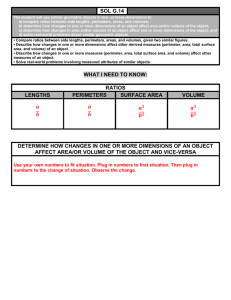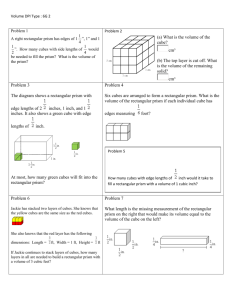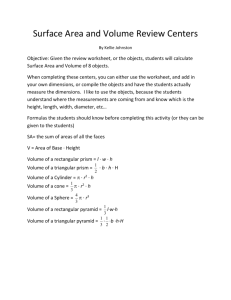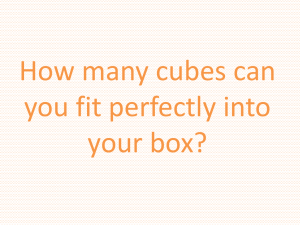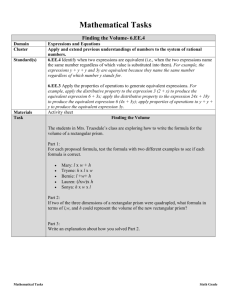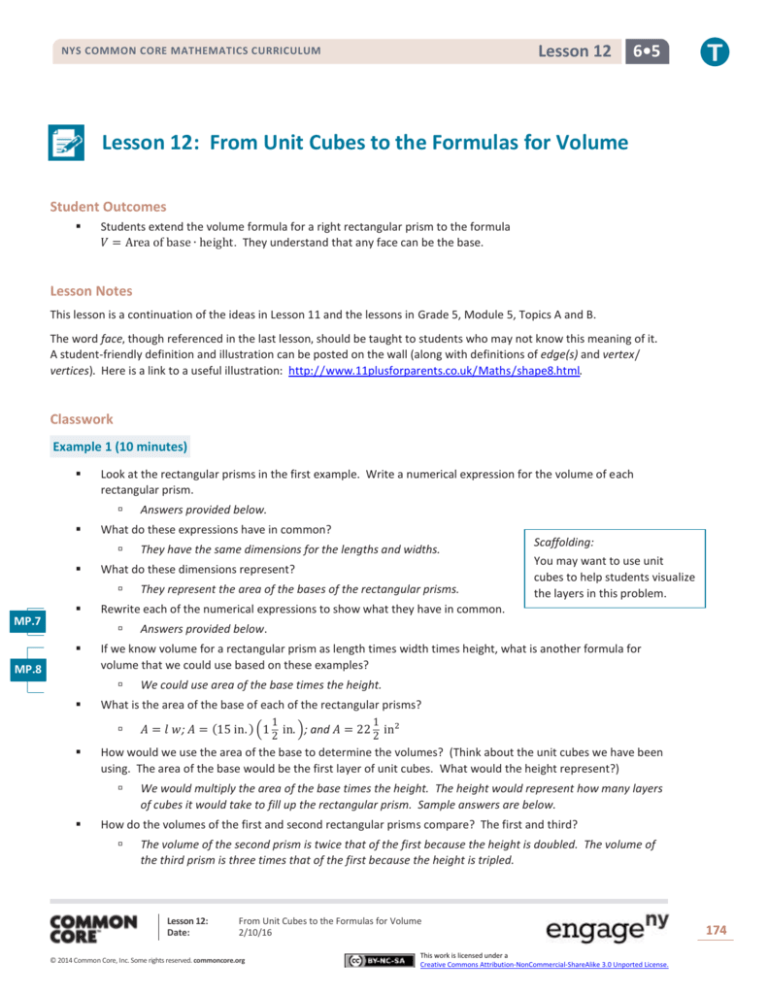
Lesson 12
NYS COMMON CORE MATHEMATICS CURRICULUM
6•5
Lesson 12: From Unit Cubes to the Formulas for Volume
Student Outcomes
Students extend the volume formula for a right rectangular prism to the formula
𝑉 = Area of base ∙ height. They understand that any face can be the base.
Lesson Notes
This lesson is a continuation of the ideas in Lesson 11 and the lessons in Grade 5, Module 5, Topics A and B.
The word face, though referenced in the last lesson, should be taught to students who may not know this meaning of it.
A student-friendly definition and illustration can be posted on the wall (along with definitions of edge(s) and vertex/
vertices). Here is a link to a useful illustration: http://www.11plusforparents.co.uk/Maths/shape8.html.
Classwork
Example 1 (10 minutes)
Look at the rectangular prisms in the first example. Write a numerical expression for the volume of each
rectangular prism.
What do these expressions have in common?
MP.8
We could use area of the base times the height.
𝐴 = 𝑙 𝑤; 𝐴 = (15 in. ) (1
1
1
in. ); and 𝐴 = 22 in2
2
2
How would we use the area of the base to determine the volumes? (Think about the unit cubes we have been
using. The area of the base would be the first layer of unit cubes. What would the height represent?)
Answers provided below.
What is the area of the base of each of the rectangular prisms?
You may want to use unit
cubes to help students visualize
the layers in this problem.
If we know volume for a rectangular prism as length times width times height, what is another formula for
volume that we could use based on these examples?
They represent the area of the bases of the rectangular prisms.
Scaffolding:
Rewrite each of the numerical expressions to show what they have in common.
They have the same dimensions for the lengths and widths.
What do these dimensions represent?
MP.7
Answers provided below.
We would multiply the area of the base times the height. The height would represent how many layers
of cubes it would take to fill up the rectangular prism. Sample answers are below.
How do the volumes of the first and second rectangular prisms compare? The first and third?
The volume of the second prism is twice that of the first because the height is doubled. The volume of
the third prism is three times that of the first because the height is tripled.
Lesson 12:
Date:
From Unit Cubes to the Formulas for Volume
2/10/16
© 2014 Common Core, Inc. Some rights reserved. commoncore.org
This work is licensed under a
Creative Commons Attribution-NonCommercial-ShareAlike 3.0 Unported License.
174
Lesson 12
NYS COMMON CORE MATHEMATICS CURRICULUM
6•5
Example 1
a.
Write a numerical expression for the volume of each of the rectangular prisms above.
(𝟏𝟓 𝐢𝐧. ) (𝟏
b.
𝟏
𝐢𝐧. ) (𝟑 𝐢𝐧. )
𝟐
(𝟏𝟓 𝐢𝐧. ) (𝟏
𝟏
𝐢𝐧. ) (𝟔 𝐢𝐧. )
𝟐
(𝟏𝟓 𝐢𝐧. ) (𝟏
𝟏
𝐢𝐧. ) (𝟗 𝐢𝐧. )
𝟐
What do all of these expressions have in common? What do they represent?
𝟏
𝟐
All of the expressions have (𝟏𝟓 𝐢𝐧. ) (𝟏 𝐢𝐧. ). This is the area of the base.
c.
Rewrite the numerical expressions to show what they have in common.
(𝟐𝟐
d.
𝟏 𝟐
𝐢𝐧 ) (𝟑 𝐢𝐧. )
𝟐
(𝟐𝟐
𝟏 𝟐
𝐢𝐧 ) (𝟔 𝐢𝐧. )
𝟐
(𝟐𝟐
𝟏 𝟐
𝐢𝐧 ) (𝟗 𝐢𝐧. )
𝟐
If we know volume for a rectangular prism as length times width times height, what is another formula for
volume that we could use based on these examples?
We could use (𝐚𝐫𝐞𝐚 𝐨𝐟 𝐭𝐡𝐞 𝐛𝐚𝐬𝐞)(𝐡𝐞𝐢𝐠𝐡𝐭), or area of the base times height.
e.
What is the area of the base for all of the rectangular prisms?
(𝟏𝟓 𝐢𝐧. ) (𝟏
f.
g.
𝟏
𝟏
𝐢𝐧. ) = 𝟐𝟐 𝐢𝐧𝟐
𝟐
𝟐
Determine the volume of each rectangular prism using either method.
(𝟏𝟓 𝐢𝐧. ) (𝟏
𝟏
𝟏
𝐢𝐧. ) (𝟑 𝐢𝐧. ) = 𝟔𝟕 𝐢𝐧𝟑
𝟐
𝟐
or
(𝟐𝟐
𝟏 𝟐
𝟏
𝐢𝐧 ) (𝟑 𝐢𝐧. ) = 𝟔𝟕 𝐢𝐧𝟑
𝟐
𝟐
(𝟏𝟓 𝐢𝐧. ) (𝟏
𝟏
𝐢𝐧. ) (𝟔 𝐢𝐧. ) = 𝟏𝟑𝟓 𝐢𝐧𝟑
𝟐
or
(𝟐𝟐
𝟏 𝟐
𝐢𝐧 ) (𝟔 𝐢𝐧. ) = 𝟏𝟑𝟓 𝐢𝐧𝟑
𝟐
(𝟏𝟓 𝐢𝐧. ) (𝟏
𝟏
𝟏
𝐢𝐧. ) (𝟗 𝐢𝐧. ) = 𝟐𝟎𝟐 𝐢𝐧𝟑
𝟐
𝟐
or
(𝟐𝟐
𝟏 𝟐
𝟏
𝐢𝐧 ) (𝟗 𝐢𝐧. ) = 𝟐𝟎𝟐 𝐢𝐧𝟑
𝟐
𝟐
How do the volumes of the first and second rectangular prisms compare? The volumes of the first and third?
𝟏𝟑𝟓 𝐢𝐧𝟑 = 𝟔𝟕
𝟐𝟎𝟐
𝟏 𝟑
𝐢𝐧 × 𝟐
𝟐
𝟏 𝟑
𝟏
𝐢𝐧 = 𝟔𝟕 𝐢𝐧𝟑 × 𝟑
𝟐
𝟐
The volume of the second prism is twice that of the first because the height is doubled. The volume of the
third prism is three times as much as the first because the height is triple the first prism’s height.
Lesson 12:
Date:
From Unit Cubes to the Formulas for Volume
2/10/16
© 2014 Common Core, Inc. Some rights reserved. commoncore.org
This work is licensed under a
Creative Commons Attribution-NonCommercial-ShareAlike 3.0 Unported License.
175
Lesson 12
NYS COMMON CORE MATHEMATICS CURRICULUM
6•5
What do you think would happen to the volume if we turn this prism on its side so
that a different face is the base? (Have students calculate the area of the base
times the height for this new prism. To help students visualize what is happening
with this rotation, you could use a textbook or a stack of index cards and discuss
how this prism is similar and/or different to the rectangular prisms in part (a).)
Answers will vary. Some students may see that the volume will be the
same no matter which face is the base.
15 in.
1
Area of the base = (3 in. ) (1 in. )
2
2
Area of the base = 4.5 in
Volume = Area of the base × height
Volume = (4
Volume = 67
1 3
in
2
1
in.
2
3 in.
The volumes in both solutions are the same.
What other expressions could we use to determine the volume of the prism?
MP.7
1
How does this volume compare with the volume you calculated using the other face as the base?
1 2
in ) (15 in. )
2
Answers will vary. Some possible variations are included below.
1
15 in. × 1 in. × 3 in.
2
1
15 in. × 3 in. × 1 in.
2
1
3 in. × 15 in. × 1 in.
2
1
45 in2 × 1 in.
2
1
1
2
2
We notice that 3 in. × 15 in. × 1 in. and 45 in2 × 1 in. are equivalent, and both represent the volume.
How do they communicate different information?
1
The first expression (3 in. × 15 in. × 1 in.) shows that the volume is the product of three edge lengths.
1
2
The second (45 in2 × 1 in.) shows that the volume is the product of the area of the base and the
2
height.
Lesson 12:
Date:
From Unit Cubes to the Formulas for Volume
2/10/16
© 2014 Common Core, Inc. Some rights reserved. commoncore.org
This work is licensed under a
Creative Commons Attribution-NonCommercial-ShareAlike 3.0 Unported License.
176
Lesson 12
NYS COMMON CORE MATHEMATICS CURRICULUM
6•5
Example 2 (5 minutes)
Example 2
The base of a rectangular prism has an area of 𝟑
𝟏
𝟏
𝐢𝐧𝟐 . The height of the prism is 𝟐 𝐢𝐧. Determine the volume of the
𝟒
𝟐
rectangular prism.
𝑽 = 𝐀𝐫𝐞𝐚 𝐨𝐟 𝐛𝐚𝐬𝐞 × 𝐡𝐞𝐢𝐠𝐡𝐭
𝟏
𝟏
𝑽 = (𝟑 𝐢𝐧𝟐 ) (𝟐 𝐢𝐧. )
𝟒
𝟐
𝟏𝟑 𝟐 𝟓
𝑽=(
𝐢𝐧 ) ( 𝐢𝐧. )
𝟒
𝟐
𝟔𝟓 𝟑
𝑽=
𝐢𝐧
𝟖
Do we need to know the length and the width to find the volume of the rectangular prism?
The length and width are needed to calculate the area of the base, and we already know the area of the
base. Therefore, we do not need the length and width. The length and width are used to calculate the
area, and we are already given the area.
Exercises (20 minutes)
The cards are printed out and used as stations or hung on the classroom walls so that students can move from question
to question. Copies of the questions can be found at the end of the lesson. Multiple copies of each question can be
printed so that a small number of students visit each question at a time. Students should spend about three minutes at
each station, where they will show their work by first writing a numerical expression, and then using the expression to
calculate the volume of the rectangular prism described. They will use the rest of the time to discuss the answers, and
the teacher can answer any questions students have about the lesson.
Card
a.
Draw a sketch of the figure. Then, calculate the
volume.
Rectangular Prism
3
Area of the base = 4 ft 2
8
1
Height = 2 ft.
2
b.
Draw a sketch of the figure. Write the length,
width, and height in feet. Then, calculate the
volume.
Rectangular Prism
3 2
1
ft ) (2 ft. )
8
2
35 2 5
𝑉=(
ft ) ( ft. )
8
2
175 3
𝑉=
ft
16
1 15
Length = 3 ft. × 2 =
ft.
2
2
3
9
Width = 3 ft. × = ft.
4
4
𝑉 = (4
𝑉=𝑙𝑤ℎ
1
Length is 2 times as long as the height.
2
3
Width is as long as the height.
4
Height = 3 ft.
Lesson 12:
Date:
Sample Response
𝑉 = Area of base × height
15
9
ft. ) ( ft. ) (3 ft. )
2
4
405 3
𝑉=
ft
8
𝑉=(
From Unit Cubes to the Formulas for Volume
2/10/16
© 2014 Common Core, Inc. Some rights reserved. commoncore.org
This work is licensed under a
Creative Commons Attribution-NonCommercial-ShareAlike 3.0 Unported License.
177
Lesson 12
NYS COMMON CORE MATHEMATICS CURRICULUM
c.
Write two different expressions to represent the
volume, and explain what each one represents.
𝟏
MP.7
𝟒
d.
𝟏
𝐦
𝟖
𝟏
𝐦
𝟑
𝟐
𝐦
𝟑
Answers will vary. Some possible solutions include
2
1
1
14
1
(4 m) ( m) (1 m) and ( m2 ) (1 m) .
3
3
8
9
8
The first expression shows the volume as a product of
the three edge lengths. The second expression,
(4
2
1
m) ( m), shows the volume as a product of the
3
3
base area times the height.
𝑉 = Area of base × height
Calculate the volume.
4
3
𝑉 = ( ft 2 ) (
ft. )
3
10
12 3
𝑉=
ft
30
2
𝑉 = ft 3
5
𝟑
𝐟𝐭.
𝟏𝟎
𝐀𝐫𝐞𝐚 =
e.
6•5
𝟒 𝟐
𝐟𝐭
𝟑
𝑉 = Area of base × height
Calculate the volume.
𝑉 = (13
𝟏
𝟏 𝐢𝐧.
𝟑
𝑉=
1 2
1
in ) (1 in. )
2
3
108 3
in
6
𝑉 = 18 in3
𝐀𝐫𝐞𝐚 = 𝟏𝟑
𝟏 𝟐
𝐢𝐧
𝟐
Lesson 12:
Date:
From Unit Cubes to the Formulas for Volume
2/10/16
© 2014 Common Core, Inc. Some rights reserved. commoncore.org
This work is licensed under a
Creative Commons Attribution-NonCommercial-ShareAlike 3.0 Unported License.
178
Lesson 12
NYS COMMON CORE MATHEMATICS CURRICULUM
f.
Challenge:
Length = 5 ft.
Determine the volume of a rectangular prism
whose length and width are in a ratio of 3: 1. The
width and height are in a ratio of 2: 3. The length
of the rectangular prism is 5 ft.
Width = 5 ft. ÷ 3 =
6•5
5
ft.
3
5
3 5
Height = ft. ×
= ft.
3
2
2
𝑉=𝑙𝑤ℎ
5
5
𝑉 = (5 ft. ) ( ft. ) ( ft. )
3
2
125 3
𝑉=
ft
6
Extension (3 minutes)
Extension
A company is creating a rectangular prism that must have a volume of 𝟔 𝐟𝐭 𝟑. The company also knows that the area of
𝟏
𝟐
the base must be 𝟐 𝐟𝐭 𝟐 . How can you use what you learned today about volume to determine the height of the
rectangular prism?
I know that the volume can be calculated by multiplying the area of the base times the height. So, if I needed the height
instead, I would do the opposite. I would divide the volume by the area of the base to determine the height.
𝑽 = 𝐀𝐫𝐞𝐚 𝐨𝐟 𝐛𝐚𝐬𝐞 × 𝐡𝐞𝐢𝐠𝐡𝐭
𝟏
𝟔 𝐟𝐭 𝟑 = (𝟐 𝐟𝐭 𝟐 ) 𝒉
𝟐
𝟏 𝟐
𝟑
𝟔 𝐟𝐭 ÷ 𝟐 𝐟𝐭 = 𝒉
𝟐
𝟐
𝟐 𝐟𝐭. = 𝒉
𝟓
Closing (2 minutes)
How is the formula 𝑉 = 𝑙 ∙ 𝑤 ∙ h related to the formula 𝑉 = Area of the base ∙ height?
When we multiply the length and width of the rectangular prism, we are actually finding the area of the
base. Therefore, the two formulas both determine the volume of the rectangular prism.
Exit Ticket (5 minutes)
Lesson 12:
Date:
From Unit Cubes to the Formulas for Volume
2/10/16
© 2014 Common Core, Inc. Some rights reserved. commoncore.org
This work is licensed under a
Creative Commons Attribution-NonCommercial-ShareAlike 3.0 Unported License.
179
Lesson 12
NYS COMMON CORE MATHEMATICS CURRICULUM
Name
6•5
Date
Lesson 12: From Unit Cubes to the Formulas for Volume
Exit Ticket
1.
Determine the volume of the rectangular prism in two different ways.
3
ft.
4
3
ft.
4
2.
3
ft.
8
The area of the base of a rectangular prism is 12 cm2 , and the height is 3
1
cm. Determine the volume of the
3
rectangular prism.
Lesson 12:
Date:
From Unit Cubes to the Formulas for Volume
2/10/16
© 2014 Common Core, Inc. Some rights reserved. commoncore.org
This work is licensed under a
Creative Commons Attribution-NonCommercial-ShareAlike 3.0 Unported License.
180
Lesson 12
NYS COMMON CORE MATHEMATICS CURRICULUM
6•5
Exit Ticket Sample Solutions
1.
Determine the volume of the rectangular prism in two different ways.
𝑽 =𝒍∙𝒘∙𝒉
𝟑
𝟒
𝑽 = 𝐀𝐫𝐞𝐚 𝐨𝐟 𝐛𝐚𝐬𝐞 ∙ 𝐡𝐞𝐢𝐠𝐡𝐭
𝟑
𝟖
𝟑
𝟒
𝑽 = ( 𝐟𝐭. ) ( 𝐟𝐭. ) ( 𝐟𝐭. )
𝑽=
𝟐𝟕
𝐟𝐭 𝟑
𝟏𝟐𝟖
𝑽=(
𝑽=
𝟑
𝐟𝐭.
𝟒
𝟗
𝟑
𝐟𝐭 𝟐 ) ( 𝐟𝐭. )
𝟑𝟐
𝟒
𝟐𝟕
𝐟𝐭 𝟑
𝟏𝟐𝟖
𝟑
𝐟𝐭.
𝟒
2.
The area of the base of a rectangular prism is 𝟏𝟐 𝐜𝐦𝟐, and the height is 𝟑
𝟑
𝐟𝐭.
𝟖
𝟏
𝐜𝐦. Determine the volume of the
𝟑
rectangular prism.
𝑽 = 𝐀𝐫𝐞𝐚 𝐨𝐟 𝐛𝐚𝐬𝐞 ∙ 𝐡𝐞𝐢𝐠𝐡𝐭
𝟏
𝐕 = (𝟏𝟐 𝐜𝐦𝟐 ) (𝟑 𝐜𝐦)
𝟑
𝟏𝟐𝟎
𝟑
𝑽=
𝐜𝐦
𝟑
𝑽 = 𝟒𝟎 𝐜𝐦𝟑
Problem Set Sample Solutions
1.
Determine the volume of the rectangular prism.
𝑽=𝒍𝒘𝒉
𝑽 = (𝟏
𝑽=
𝟏
𝟏
𝟕
𝐦) ( 𝐦) ( 𝐦)
𝟐
𝟐
𝟖
𝟕
𝐦
𝟖
𝟐𝟏 𝟑
𝐦
𝟑𝟐
𝟏
𝐦
𝟐
𝟏
𝟏 𝐦
𝟐
2.
The area of the base of a rectangular prism is 𝟒
𝟑
𝟒
𝐟𝐭 𝟐, and the height is 𝟐
𝟏
𝟑
𝐟𝐭. Determine the volume of the
rectangular prism.
𝑽 = 𝐀𝐫𝐞𝐚 𝐨𝐟 𝐛𝐚𝐬𝐞 × 𝐡𝐞𝐢𝐠𝐡𝐭
𝑽 = (𝟒
𝟑 𝟐
𝟏
𝐟𝐭 ) (𝟐 𝐟𝐭. )
𝟒
𝟑
𝟏𝟗 𝟐 𝟕
𝑽=(
𝐟𝐭 ) ( 𝐟𝐭. )
𝟒
𝟑
𝑽=
𝟏𝟑𝟑 𝟑
𝐟𝐭
𝟏𝟐
Lesson 12:
Date:
From Unit Cubes to the Formulas for Volume
2/10/16
© 2014 Common Core, Inc. Some rights reserved. commoncore.org
This work is licensed under a
Creative Commons Attribution-NonCommercial-ShareAlike 3.0 Unported License.
181
Lesson 12
NYS COMMON CORE MATHEMATICS CURRICULUM
3.
6•5
𝟏
𝟏
𝟐
The length of a rectangular prism is 𝟑 times as long as the width. The height is of the width. The width is 𝟑 𝐜𝐦.
𝟒
Determine the volume.
𝐖𝐢𝐝𝐭𝐡 = 𝟑 𝐜𝐦
𝐋𝐞𝐧𝐠𝐭𝐡 = 𝟑 𝐜𝐦 × 𝟑
𝐇𝐞𝐢𝐠𝐡𝐭 = 𝟑 𝐜𝐦 ×
𝟏 𝟐𝟏
=
𝐜𝐦
𝟐
𝟐
𝟏 𝟑
= 𝐜𝐦
𝟒 𝟒
𝑽=𝒍𝒘𝒉
𝟐𝟏
𝟑
𝑽=(
𝐜𝐦) (𝟑 𝐜𝐦) ( 𝐜𝐦)
𝟐
𝟒
𝑽=
𝟏𝟖𝟗
𝐜𝐦𝟑
𝟖
4.
𝟔 𝐢𝐧.
𝟏
𝟏
𝟏𝟎 𝐢𝐧.
𝟐
a.
𝟐
𝐢𝐧.
𝟑
Write numerical expressions to represent the volume in two different ways, and explain what each reveals.
(𝟏𝟎
𝟏
𝟐
𝟑𝟓
𝐢𝐧. ) (𝟏 𝐢𝐧. ) (𝟔 𝐢𝐧. ) represents the product of three edge lengths. ( 𝒊𝒏𝟐 ) (𝟔 𝒊𝒏) represents the
𝟐
𝟑
𝟐
product of the base area times the height. Answers will vary.
b.
Determine the volume of the rectangular prism.
(𝟏𝟎
5.
𝟏
𝟐
𝟑𝟓 𝟐
𝐢𝐧. ) (𝟏 𝐢𝐧. ) (𝟔 𝐢𝐧. ) = 𝟏𝟎𝟓 𝐢𝐧𝟑 or (
𝐢𝐧 ) (𝟔 𝐢𝐧. ) = 𝟏𝟎𝟓 𝐢𝐧𝟑
𝟐
𝟑
𝟐
An aquarium in the shape of a rectangular prism has the following dimensions: length = 𝟓𝟎 𝐜𝐦, width = 𝟓
and height = 𝟑𝟎
a.
𝟏
𝐜𝐦.
𝟐
Write numerical expressions to represent the volume in two different ways, and explain what each reveals.
(𝟓𝟎 𝐜𝐦) (𝟐𝟓
𝟏
𝟏
𝐜𝐦) (𝟑𝟎 𝐜𝐦) represents the product of the three edge lengths.
𝟐
𝟐
(𝟏𝟐𝟕𝟓 𝐜𝐦𝟐 ) (𝟑𝟎
b.
𝟏
𝐜𝐦,
𝟐
𝟏
𝐜𝐦) represents the base area times the height.
𝟐
Determine the volume of the rectangular prism.
(𝟏𝟐𝟕𝟓 𝐜𝐦𝟐 ) (𝟑𝟎
Lesson 12:
Date:
𝟏
𝟏
𝐜𝐦) = 𝟑𝟖𝟖𝟖𝟕 𝐜𝐦𝟑
𝟐
𝟐
From Unit Cubes to the Formulas for Volume
2/10/16
© 2014 Common Core, Inc. Some rights reserved. commoncore.org
This work is licensed under a
Creative Commons Attribution-NonCommercial-ShareAlike 3.0 Unported License.
182
Lesson 12
NYS COMMON CORE MATHEMATICS CURRICULUM
6.
6•5
The area of the base in this rectangular prism is fixed at 𝟑𝟔 𝐜𝐦𝟐. This means that for the varying heights, there will
be various volumes.
a.
b.
Complete the table of values to determine the various heights and volumes.
Height in Centimeters
Volume in Cubic
Centimeters
𝟏
𝟑𝟔
𝟐
𝟕𝟐
𝟑
𝟏𝟎𝟖
𝟒
𝟏𝟒𝟒
𝟓
𝟏𝟖𝟎
𝟔
𝟐𝟏𝟔
𝟕
𝟐𝟓𝟐
𝟖
𝟐𝟖𝟖
𝟑 𝐜𝐦
𝟏𝟐 𝐜𝐦
Write an equation to represent the relationship in the table. Be sure to define the variables used in the
equation.
Let 𝒙 be the height of the rectangular prism in centimeters.
Let 𝒚 be the volume of the rectangular prism in cubic centimeters.
𝟑𝟔𝒙 = 𝒚
c.
What is the unit rate for this proportional relationship? What does it mean in this situation?
The unit rate is 𝟑𝟔.
For every centimeter of height, the volume increases by 𝟑𝟔 𝐜𝐦𝟑 because the area of the base is 𝟑𝟔 𝐜𝐦𝟐. In
order to determine the volume, multiply the height by 𝟑𝟔.
7.
The volume of a rectangular prism is 𝟏𝟔. 𝟑𝟐𝟖 𝐜𝐦𝟑 . The height is 𝟑. 𝟏𝟒 𝐜𝐦.
a.
Let 𝑩 represent the area of the base of the rectangular prism. Write an equation that relates the volume, the
area of the base, and the height.
𝟏𝟔. 𝟑𝟐𝟖 = 𝟑. 𝟏𝟒𝑩
b.
Solve the equation for 𝑩.
𝟏𝟔. 𝟑𝟐𝟖 𝟑. 𝟏𝟒𝑩
=
𝟑. 𝟏𝟒
𝟑. 𝟏𝟒
𝑩 = 𝟓. 𝟐
The area of the base is 𝟓. 𝟐 𝐜𝐦𝟐.
Lesson 12:
Date:
From Unit Cubes to the Formulas for Volume
2/10/16
© 2014 Common Core, Inc. Some rights reserved. commoncore.org
This work is licensed under a
Creative Commons Attribution-NonCommercial-ShareAlike 3.0 Unported License.
183
Lesson 12
NYS COMMON CORE MATHEMATICS CURRICULUM
6•5
Station A
Make a sketch of the figure. Then, calculate the volume.
Rectangular prism:
𝟑
𝟖
Area of the base = 𝟒 𝐟𝐭 𝟐
Height = 𝟐
Lesson 12:
Date:
𝟏
𝐟𝐭.
𝟐
From Unit Cubes to the Formulas for Volume
2/10/16
© 2014 Common Core, Inc. Some rights reserved. commoncore.org
This work is licensed under a
Creative Commons Attribution-NonCommercial-ShareAlike 3.0 Unported License.
184
Lesson 12
NYS COMMON CORE MATHEMATICS CURRICULUM
6•5
Station B
Make a sketch of the figure. Write the length, the width, and
height in feet. Then, calculate the volume.
Rectangular prism:
𝟏
𝟐
Length is 𝟐 times the height.
𝟑
Width is as long as the height.
𝟒
Height = 𝟑 𝐟𝐭.
Lesson 12:
Date:
From Unit Cubes to the Formulas for Volume
2/10/16
© 2014 Common Core, Inc. Some rights reserved. commoncore.org
This work is licensed under a
Creative Commons Attribution-NonCommercial-ShareAlike 3.0 Unported License.
185
Lesson 12
NYS COMMON CORE MATHEMATICS CURRICULUM
6•5
Station C
Write two different expressions to represent the volume, and
explain what each expression represents.
𝟏
𝟒
Lesson 12:
Date:
𝟏
𝐦
𝟖
𝟏
𝐦
𝟑
𝟐
𝐦
𝟑
From Unit Cubes to the Formulas for Volume
2/10/16
© 2014 Common Core, Inc. Some rights reserved. commoncore.org
This work is licensed under a
Creative Commons Attribution-NonCommercial-ShareAlike 3.0 Unported License.
186
Lesson 12
NYS COMMON CORE MATHEMATICS CURRICULUM
6•5
Station D
Calculate the volume.
𝟑
𝐟𝐭.
𝟏𝟎
𝐀𝐫𝐞𝐚 =
Lesson 12:
Date:
𝟒 𝟐
𝐟𝐭
𝟑
From Unit Cubes to the Formulas for Volume
2/10/16
© 2014 Common Core, Inc. Some rights reserved. commoncore.org
This work is licensed under a
Creative Commons Attribution-NonCommercial-ShareAlike 3.0 Unported License.
187
Lesson 12
NYS COMMON CORE MATHEMATICS CURRICULUM
6•5
Station E
Calculate the volume.
𝟏
𝟏
𝐢𝐧.
𝟑
𝐀𝐫𝐞𝐚 = 𝟏𝟑
Lesson 12:
Date:
𝟏 𝟐
𝐢𝐧
𝟐
From Unit Cubes to the Formulas for Volume
2/10/16
© 2014 Common Core, Inc. Some rights reserved. commoncore.org
This work is licensed under a
Creative Commons Attribution-NonCommercial-ShareAlike 3.0 Unported License.
188
Lesson 12
NYS COMMON CORE MATHEMATICS CURRICULUM
6•5
Station F
Challenge:
Determine the volume of a rectangular prism whose length and
width are in a ratio of 𝟑:𝟏. The width and height are in a ratio of
𝟐:𝟑. The length of the rectangular prism is 𝟓 𝐟𝐭.
Lesson 12:
Date:
From Unit Cubes to the Formulas for Volume
2/10/16
© 2014 Common Core, Inc. Some rights reserved. commoncore.org
This work is licensed under a
Creative Commons Attribution-NonCommercial-ShareAlike 3.0 Unported License.
189

